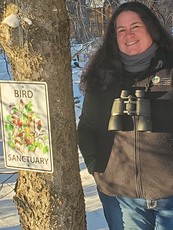
My Birding Adventure...so far
By Nicola Bradley-Blake
Nicola, pictured to the right, is a BOW steering committee member and volunteer BOW birding instructor.
I grew up in east-central Minnesota, an area that some people refer to as “the sticks” and others as “God’s Country.” We lived a half-mile from our nearest neighbor and nature abounded. There were not any city disturbances such as lights to drown out the night sky or constant traffic to hide the sounds of nature at all hours. In this natural setting, I connected to nature in a way that I miss now that I live in the city. As a result, these days I work to make my yard wildlife and bird friendly.
My father was a farmer so we were up early every day to do our chores. Living and working on a farm, there were always birds around to learn about and enjoy. My father was not an educated man but he started my interest in birds by teaching me the ones he knew. Some birds he named creatively… mud daubers (Cliff Swallows), sump pumpers (American Bittern), and wild canaries (American Goldfinch), for example. He knew the common ones, including robins, ruby-throated hummingbirds, mourning doves, white-breasted nuthatches, and red-winged blackbirds. He also knew the birds that name themselves by their calls - killdeer, black-capped chickadee, catbird, and Blue Jay - or by their choice of home, such as barn swallows. I found myself watching birds and taking elective courses in high school that had to do with nature. That is where I learned more about birds and their calls. I would later learn the correct names of the birds I knew locally.
When I went off to college, it did not surprise my parents that I wanted to focus on biology, ecology and the natural world. My advisor was BIG into ornithology and encouraged my interest. I met other professors and staff who were birders and encouraged me to join the local Audubon Society. Eventually, I did join the local chapter and I have enjoyed birding with other enthusiasts over the years. I still consider myself a relative amateur when it comes to birding, though. Birding is a hobby for me, and I still have much to learn.
So, what does one need to become a birder? There isn’t special clothing, really, but I always recommend dressing in layers for Minnesota weather (if you’re going to be outside) and proper footwear for the terrain you plan to walk (if you’re walking). You do NOT need a degree! Curiosity and desire are the two big ones, in my opinion. A guide (either human or book or even a telephone app), binoculars (optional, but they sure help), time and a place to watch birds round out my list of “must haves”. I feel like anyone can bird anywhere, at any time, for any amount of time!
When I start to try to identify a bird, I first look at their size and shape compared to something I already know (robin or goose, for example). Then I start looking for field markings (beak or bill, feet, and colors). I also note where they are (pond, forest, prairie, yard, etc.) and what they are doing (behavior). If they were calling, what did it sound like? If I cannot figure out what I was looking at, those characteristics will help other birders help me to narrow it down or figure it out.
What I would say to anyone that has an interest in birding is to give yourself time and a break. You do not have to learn every bird overnight and you already know more than you might think. Never feel silly asking others for help. Most birders are happy to assist a new birder… or even an “old” birder! The last year and social distancing seemed to cause an increase in birdwatching, both in the field and the back yard. I hope that people find the same joy in watching birds’ antics as much as I do!
|